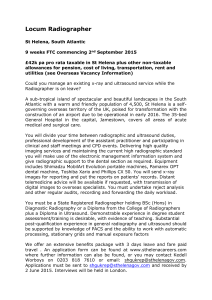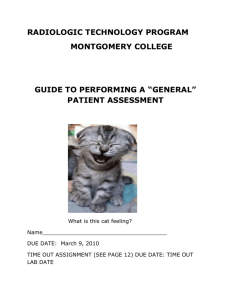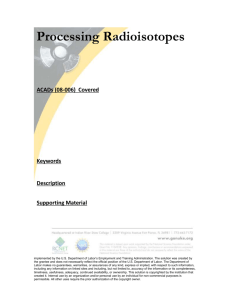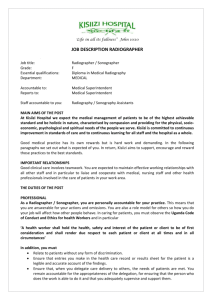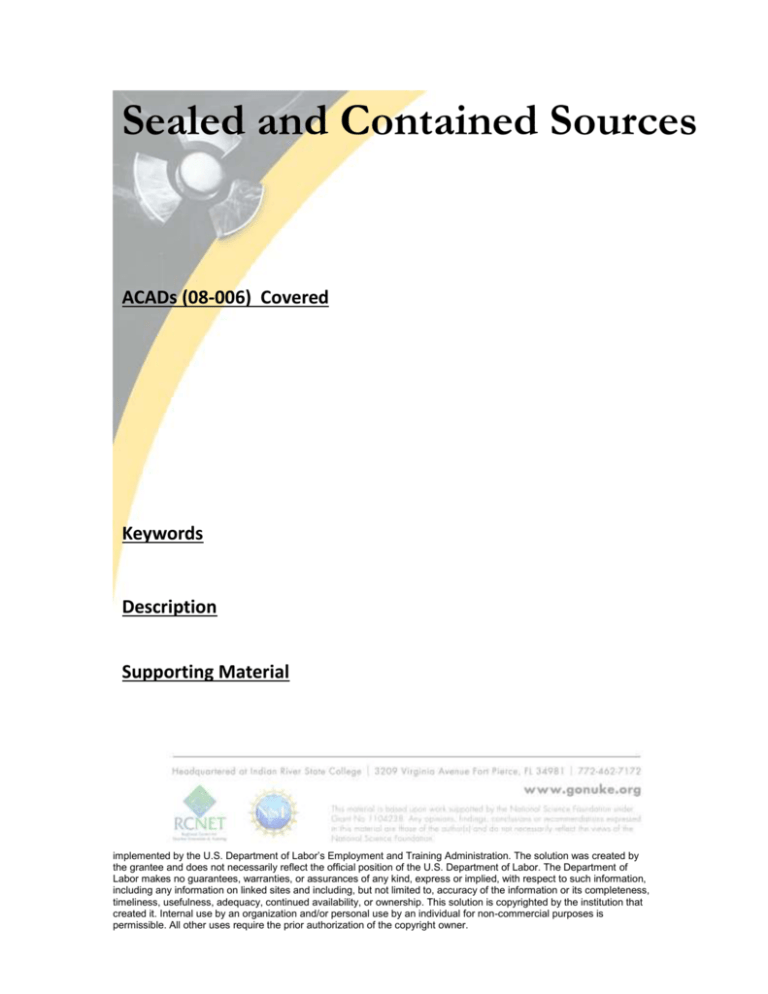
Sealed and Contained Sources
ACADs (08-006) Covered
Keywords
Description
Supporting Material
Copyright © 2008-2009 - Curators of the University of Missouri, in collaboration with Linn
State Technical College. All rights reserved. DMCA and other copyright information.
This workforce solution was funded by a grant awarded under the President’s High-Growth Job Training Grants as
implemented by the U.S. Department of Labor’s Employment and Training Administration. The solution was created by
the grantee and does not necessarily reflect the official position of the U.S. Department of Labor. The Department of
Labor makes no guarantees, warranties, or assurances of any kind, express or implied, with respect to such information,
including any information on linked sites and including, but not limited to, accuracy of the information or its completeness,
timeliness, usefulness, adequacy, continued availability, or ownership. This solution is copyrighted by the institution that
created it. Internal use by an organization and/or personal use by an individual for non-commercial purposes is
permissible. All other uses require the prior authorization of the copyright owner.
RPT 243
Instructional Resources
Module 1 Sealed and Contained Sources
The Curators of the University of Missouri
Copyright © 2008-2009
A Product of DOL Grant # HG-15355-06-60
Page 1
RPT 243
Instructional Resources
Module 1: Sealed and Contained Sources
Table of Contents:
Resources Key .................................................................................................................... 3
Module Readings and Homework ...................................................................................... 3
Primary Scenario “Exposure of Radiography Personnel Due to Source Malfunction”.. 3
Transfer Scenario “Exposure of Radiography Personnel Due to Miscommunication” .. 4
Primary Scenario “Exposure of Worker to 22 REM Shallow Dose Equivalent (SDE)
from 90Sr Check Source” ................................................................................................ 4
Transfer Scenario “Exposure of Personnel during Inter-facility Movement of Highly
Radioactive Material” ..................................................................................................... 4
Transfer Scenario Original Event Descriptions .................................................................. 5
Transfer Scenario “Exposure of Radiography Personnel Due to Miscommunication” .. 5
Transfer Scenario “Exposure of Personnel during Inter-facility Movement of Highly
Radioactive Material” ..................................................................................................... 6
Module Assessment Items .................................................................................................. 7
Primary Scenario “Exposure of Radiography Personnel Due to Source Malfunction” .. 7
ACAD References .............................................................................................................. 8
RPT 243 Instructor’s Guide
The Curators of the University of Missouri
Copyright © 2008-2009
A Product of DOL Grant # HG-15355-06-60
Page 2
RPT 243
Instructional Resources
Resources Key
This refers This reference:
to:
ACAD
National Academy for Nuclear Training, Uniform Curriculum Guide for
Nuclear Power Plant Technician, Maintenance, and Nonlicensed
Operations Personnel Associate Degree Programs, ACAD 08-006.
DOE-SG
Office of Environmental, Safety and Health: Radiological Control
Technician Training Site Academic Training Study Guide Phase I,
Project Number TRNG-0003
G.
Available at: http://nsedu.rnet.missouri.edu/docshare/. File is located
under the Docs/General Curriculum/DOE materials folder.
Gollnick, D. (2006). Basic Radiation Protection Technology, 5th Ed.
Pacific Radiation Corporation, Altadena, CA.
Module Readings and Homework
Primary Scenario “Exposure of Radiography Personnel Due to
Source Malfunction”
Core Concept: Techniques and precautions for minimizing localized exposure from sealed
sources of gamma radiation
Homework
Readings
Calculation Items
Non-calculation Items
DOE-SG-Mod 2.08-2 to 2.08-4
N\A
N\A
Core Concept: Response to radiation exposure from lost, misplaced or unexpected sealed
sources of radiation
Homework
Readings
Calculation Items
Non-calculation Items
N\A
G., Chap. 5, # S-6
N\A
Core Concept: Safe work practices around physically small sources of radiation
Homework
Readings
Calculation Items
Non-calculation Items
N\A
N\A
N\A
Core Concept: Safe work practices in rapidly changing radiological conditions
Homework
Readings
Calculation Items
Non-calculation Items
DOE-SG-Mod 2.13-9
N\A
DOE-SG-Mod 2.13.06
Module 1 Sealed and Contained Sources
The Curators of the University of Missouri
Copyright © 2008-2009
A Product of DOL Grant # HG-15355-06-60
Page 3
RPT 243
Instructional Resources
Transfer Scenario “Exposure of Radiography Personnel Due to
Miscommunication”
Refer to readings and homework for primary scenario above.
The complete text of the event for this scenario is in the section “Transfer Scenario
Original Event Descriptions” below.
Primary Scenario “Exposure of Worker to 22 REM Shallow Dose
Equivalent (SDE) from 90Sr Check Source”
Core Concept: Techniques and precautions for minimizing localized exposure from
contained, movable sources of beta radiation
Homework
Readings
Calculation Items
Non-calculation Items
N\A
N\A
N\A
Core Concept: Radiological surveying for pure beta-emitting isotopes
Homework
Readings
Calculation Items
Non-calculation Items
G., Chap.12, 512 – 518
G., Chap.12, # 16
DOE-SG-Mod 2.13.04
DOE-SG-Mod 2.13-6 – 2.13-8
Transfer Scenario “Exposure of Personnel during Inter-facility
Movement of Highly Radioactive Material”
Refer to readings and homework for primary scenario above.
The complete text of the event for this scenario is in the section “Transfer Scenario
Original Event Descriptions” below.
RPT 243 Instructor’s Guide
The Curators of the University of Missouri
Copyright © 2008-2009
A Product of DOL Grant # HG-15355-06-60
Page 4
RPT 243
Instructional Resources
Transfer Scenario Original Event Descriptions
Use the complete text of these events to assess students’ ability to analyze the event, and apply
appropriate safety and response procedures.
Transfer Scenario “Exposure of Radiography Personnel Due to
Miscommunication”
Description: A pre-job briefing was conducted in which the radiography team discussed the
radiography plan, personnel responsibilities, and operating experience. Before radiography
commenced, the boundaries and the exposure area were walked down by the lead radiographer
and radiation protection shift supervisor, as required by procedure. Several radiography shots
were performed on various welds throughout the night without incident. At approximately 0430,
the source camera operator lead radiographer entered the area with a dose rate meter to ensure
the source was properly retracted into the source camera. Subsequently, he allowed a second
radiographer (the film positioner) to enter the area in order to remove the used film and place the
film pack for the next exposure. The lead radiographer proceeded to position the source
collimator for the next shot. When the lead radiographer had completed his work he retreated to
the area from which the source was controlled.
The lead radiographer commenced exposing the source before verifying with three way
communication, as directed by the radiography procedure, that the second radiographer had
returned from positioning the film packs and the area was cleared of all personnel. As the second
radiographer exited the area he received an instantaneous dose rate alarm caused by exposure
to the source as it moved through the source guide tube to the collimator. The electronic
dosimeter recorded a maximum dose rate of 1050 mrem/hour for about one second. As required
by the site radiation work permit, the radiography operations were stopped and the dose rate
alarm reported to the radiation protection shift supervisor. The resulting cumulative exposure to
the second radiographer for this shot and all previous work was 2 mrem by electronic dosimeter.
The second radiographer's TLD was processed. The TLD read 10 mrem for the quarter as
compared to previous RWP dose of 12 mrem. On previous occasions, the second radiographer
had completed positioning film packs and retreated from the exposure area prior to the lead
radiographer leaving the area.
Immediate actions taken were to suspend performance of all radiography at all fleet facilities by
the fleet Radiography Organization pending completion of an incident investigation.
Causes: Root cause analysis was performed and determined that the cause was a human
performance skill based error. This was based on the lead radiographer's assumption that the
second radiographer had, as in each previous exposure, exited the exposure area before him.
The lead radiographer acted on that assumption, rather than positively verifying the second
individual had exited, and exposed the source.
Corrective Actions: 1) Revisions to the Industrial Radiography Operating and Emergency
procedures to incorporate specific instructions for verification that all radiography personnel are
out of the exposure area prior to exposing the source, specific requirements for the use of human
performance error prevention tools during the conduct of radiography, and a place holding
checklist for critical steps in the radiography process; and 2) Retraining of all radiography
personnel.
Module 1 Sealed and Contained Sources
The Curators of the University of Missouri
Copyright © 2008-2009
A Product of DOL Grant # HG-15355-06-60
Page 5
RPT 243
Instructional Resources
Transfer Scenario “Exposure of Personnel during Inter-facility
Movement of Highly Radioactive Material”
Description: Two plant personnel received unanticipated radiation dose rate alarms during the
movement of highly radioactive material. The personnel who received the alarms were not
involved in the evolution of moving the highly radioactive material packages from one location to
another. A pre-job brief was conducted prior to the evolution. The radiation protection (RP)
specialist overseeing the task also was performing duties as a boundary guard.
The RP specialist was stationed at the T-Tunnel 123’ elevator door as briefed with all individuals
involved. The RP specialist had intentions of performing the oversight activity where the drums
were to be located at radwaste (RW) 106’ elevation. The drum was placed in the elevator at the
65’ elevation by the appropriate RP technician with the RP specialist stationed at T-Tunnel 123’
elevation. Once arriving at the 106' elevation, the RP specialist noted that the elevator had not
stopped at that location. The RP specialist returned to the 123’ elevation and two plant personnel
had already approached the elevator and were in close proximity to the opening when the
elevator door opened, giving the two workers electronic dosimeter dose rate alarms. The RP
specialist immediately removed the workers from the area and sent the elevator to the RW 106'
elevation and directed the workers to exit the radiologically controlled area.
Causes: The RP specialist in charge of the task chose to assign himself dual roles as a pathway
guard while retaining responsibility for oversight of the task. This became a human performance
trap that influenced the evolution (multi-tasking). A non-conservative decision was made to
abandon the pathway guard post. The RP specialist in charge did not have adequate
communications to allow for better coordination of the activity.
Corrective Actions: Review the methods used for protecting personnel during high radioactive
material movements. Revise plant procedures to add a checklist to address the steps needed to
prepare and execute the movement of high radioactive material and or waste.
RPT 243 Instructor’s Guide
The Curators of the University of Missouri
Copyright © 2008-2009
A Product of DOL Grant # HG-15355-06-60
Page 6
RPT 243
Instructional Resources
Module Assessment Items
Note: If instructors wish to increase the difficulty of any item, then we suggest
you use it as the basis for an in-class discussion, and / or require students to
write an explanation for why a particular choice is correct.
Primary Scenario “Exposure of Radiography Personnel Due to
Source Malfunction”
Assessment Items:
John and Susan are radiography technicians performing radiographic testing of welds with a 50
Curie 60Co source. They are all set up and ready to expose the source. Susan calls John on their
portable radio and says, “I’m ready to move the source to the collimator.” John replies, “Go
ahead, I’m on my way out of the area.”
Susan doesn’t waste any time and quickly cranks out the source to the collimator and then
notifies John; “The source is exposed.”
John’s electronic dosimeter (ED) alarms on “dose rate” for about 2 seconds and then silences.
After he hears the ED alarm, John quickly turns on his portable survey meter and checks for
increased dose rates. Everything looks normal – no increased dose rates. John replies to Susan,
“My radio must have caused my ED to alarm.” John checks his ED and sees accumulated dose
at 10 mrem (100 μSv). His ED dose rate alarm set point was 20 mrem/hour (200 μSv/hour) and
the dose alarm set point was 15 mrem/hour (150 μSv). He says to himself, “This is probably due
to radio interference” and then leaves the restricted area to monitor the boundaries.
After the determined exposure time, Susan notifies John, “I’m retracting the source” and then
quickly does so.
John replies, “Go ahead, I’m outside the area.”
Susan joins John outside the restricted area and declares, “Well that’s the last shot, lets take a
break and then we can secure everything. I’ll check the source position in the camera when we
get back.” They go to the break room together and discuss John’s ED alarm. They attribute it to
radio interference and hurry back to the work area so they can get everything “wrapped up”
before the mid shift ends.
1. (Inference) What was John’s FIRST human performance mistake?
a. Having his survey meter off when the source was exposed.
b. Assuming his ED alarm was due to radio interference.
c. Not having a questioning attitude when his ED alarmed
d. Not using 3-way communications with Susan. (correct)
2. (Inference) What was Susan’s FIRST human performance mistake?
a. Using a portable radio to communicate with.
b. Exposing the source without verifying that John was out of the restricted area.
c. Not using 3-way communications with John. (correct)
d. Leaving the source unattended.
Module 1 Sealed and Contained Sources
The Curators of the University of Missouri
Copyright © 2008-2009
A Product of DOL Grant # HG-15355-06-60
Page 7
RPT 243
Instructional Resources
3. (Inference) What was the likely cause of John’s ED dose rate alarm?
a. His ED dose rate alarm set point was inappropriate for the source strength.
b. His ED dose alarm set point was inappropriate for the source strength
c. Susan exposing the source before John was out of the restricted area. (correct)
d. Radio interference with his ED.
4. (Prediction) Which reading below would have changed most if the source became stuck
in the guide tube while on its way to the collimator?
a. John’s ED dose
b. John’s ED dose rate (correct)
c. The restricted area boundary dose rate
d. The restricted area boundary dose
5. (Inference) Which immediate response action should have been taken when John’s ED
alarmed?
a. John should have immediately left the restricted area.
b. Susan should have immediately retracted the source into the camera.
c. John should have immediately changed the scale on his survey meter.
d. Susan and John should have secured from radiography operations. (correct)
ACAD References
Note: ACADs listed in the RPT 243 instructors’ guide introduction document may also
apply.
ACAD
3.3.8 EXTERNAL EXPOSURE CONTROL
Explain the differences between general area dose rate and contact
dose rate and how each is used to control exposures. Explain the
difference between loose and fixed contamination.
RPT 243 Instructor’s Guide
The Curators of the University of Missouri
Copyright © 2008-2009
A Product of DOL Grant # HG-15355-06-60
Page 8


